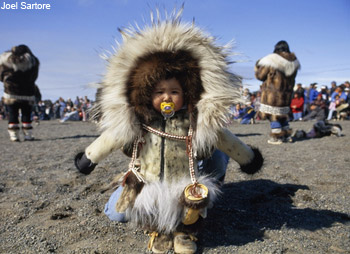Integrated Management in the Arctic: Using All the Information
What is an Integrated Arctic Management Plan?
An integrated management plan for the Arctic offers a promising way to achieve a balance among the differing needs of industry, local communities, and ecosystems in a region undergoing profound and rapid changes. Pew is examining what an integrated management framework might look like for the U.S. Arctic Ocean off Alaska's north coast.
Any form of integrated management should be guided by peer-reviewed science, traditional knowledge, and transparent decision-making. Arctic indigenous peoples have practiced a subsistence way of life since time immemorial. As such, the human place in the ecosystem is an essential element of an integrated management plan.
Guiding Principles
- Value People: Ensure that local, indigenous communities are part of the process; use co-management
 Practice Transparency: The decision-making process should be clearly laid out and include a procedure for stakeholder input. Scientific documents should be peer-reviewed.
Practice Transparency: The decision-making process should be clearly laid out and include a procedure for stakeholder input. Scientific documents should be peer-reviewed.- Acknowledge Trade-offs: When a decision is made, there are always consequences and risks; to maintain transparency, consequences and risks must be recognized and stated.
- Incorporate Traditional Knowledge: Indigenous residents have a long-standing knowledge base that should be a component of the management plan. Procedures for the inclusion of traditional knowledge should be integrated throughout the process.
- Apply Adaptive Management: Conduct periodic syntheses of research findings for scientists, decision makers, communities, and the general public to see whether a comprehensive and integrated monitoring plan adequately addresses decision-making. As new information becomes available, revise the plan accordingly. Adaptive management should directly inform development and management decisions.
Working Toward Integrated Arctic Management: Recommended Steps
In the absence of a long-term plan, federal agencies could take immediate action in five areas by applying integrated management principles to industrial activity in the U.S. Arctic Ocean:
Given the challenges facing the Arctic, it is essential to manage the region's natural resources in an integrated manner to avoid conflicts and provide for greater environmental protection while still operating commercial activities.-Secretary of the Interior Ken Salazar
- Protect known important ecologically and traditionally sensitive areas from disruption by industrial activities.
- Keep any new lease areas small and targeted to ensure we have a better understanding of the ecosystem and know whether, when, where, and how activity is, or may be mitigated to be, appropriate.
- Develop and implement an integrated and comprehensive Arctic ecosystem monitoring, observation, and research (MOR) program with substantial long-term funding, a mission of protecting the health and biodiversity of the Arctic, and a robust monitoring program that guides decision-making.
- Better assess cumulative impacts and understand long-term implications of decisions made today by creating various scenarios that show how the future might look in the Arctic. Determine the additive and interactive effect of impacts on natural and social resources over both time and space. Require such assessments before action is taken, and update them regularly.
- Include indigenous Arctic residents, their knowledge, and their health and well-being as key components of Arctic ecosystems and their management.
The Pew Environment Group's U.S. Arctic Program promotes science- and community-based conservation that reduces the risks to the U.S. Arctic Ocean from climate change and industrial development. The program's science-based initiatives include:
- Working to implement integrated management practices in the U.S. Arctic.
- Ensuring that the Department of the Interior develops a long-term integrated research and monitoring plan to guide decisions on whether, where, when, and how offshore oil and gas drilling can take place.
- Securing an oil and gas leasing program that explicitly designates and protects important subsistence and ecological areas in the Beaufort and Chukchi seas.
- Promoting Arctic-specific spill prevention and response standards for all companies operating in the region.
- Developing and implementing shipping safety and conservation measures in the Bering Strait and Aleutian Islands.











